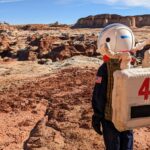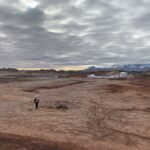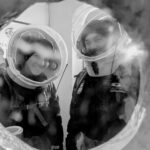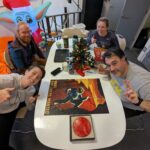Crew 271 Sol 5 Journalist Report 23-12-2022
Sol: 5
Author’s name: Helen Eifert, Crew Geologist
Title: Grease Lightning
To celebrate our first full day in sim last night, the IMARS crew watched The Martian for a movie night. With an analog astronaut crew full of real aspiring astronauts, we were all left stewing on the science and wonders of real space travel. Our EVA requests were submitted, with every crew member getting a space walk. Luckily, no potatoes were needed today.
In the morning, Guariniello and Eifert returned to the experiment site north of the Hab for additional measurements. The clay rich environment still appears wet a full 24 hours after saturation. The squiggly lines should confirm what we see with our eyes in the form of a key absorption at a particular wavelength of reflected light. This elbow macaroni shape alerts us water has made its way into the chemical structures of the surface material. We collected a dry sample nearby so that we may better understand the initial water content and how long it takes for our experiment site to return to equilibrium. A short and sweet EVA that nearly ended in disaster when Sergii almost blew out the airlock before depressurization was complete. Danger is ever present in space, so heed my warning not to coordinate a stadium wave in the airlock because it may mis-alert the crew on station.
After our short EVA, I spent the rest of the day holding down the Hab with Cesare. The remaining crew members took a long rover drive out towards Lith. The whole EVA was described by Grete as an “exertion excursion” since the rovers didn’t make it the full distance to their destination. The four astronauts continued on foot for many kilometers testing the comms. Commander Levesque, a licensed amateur radio operator, recently set up a repeater west of the Hab to improve radio communications amongst astronauts for long distance EVAs. The findings are in and improvements are needed. The fun fact of the day is that the background static that disrupts radio chatter is referred to as “grease.” The chicks do not scream for this grease lightning, but it did give us a great excuse to call each other greasy all day. Apt, given we are at Sol 5 and our water consumption has been low enough to afford some much needed showers this evening. Solving two grease problems in one day here on Mars.
Something that was not greasy, was the beef stew cooked up in the Hab throughout the entire second EVA. With tomato powder, freeze dried beef crumbles, dehydrated veggies, bouillon granules, and potato chips, we enjoyed another successful day on Mars with a healthy, hearty meal. Guess we needed potatoes after all. Cesare baked another loaf of bread to pair with the stew. Fresh bread does not last long on station, particularly when baked with parmesan and fresh herbs from the GreenHab, courtesy of Alicyn. All of her pull-ups are paying dividends for herculean harvesting of epic proportions. She has the strongest green thumb I’ve ever seen, putting inflatable baby Yoda to shame.
If you are wondering how many astronauts it takes to do a jigsaw puzzle, the question is moot. We finished two puzzles in under two hours with speed and precision. Andres, crew researcher and resident psychologist, notified me that our crew cohesion levels have increased one point today. I am suspicious he is only saying this so we cease our threats to chop off his dreads and shave his mustache. Can you blame us, though? NASA hates fires, so we’re dead set on minimizing all the grease we can muster. No hair is safe on Mars.








You must be logged in to post a comment.